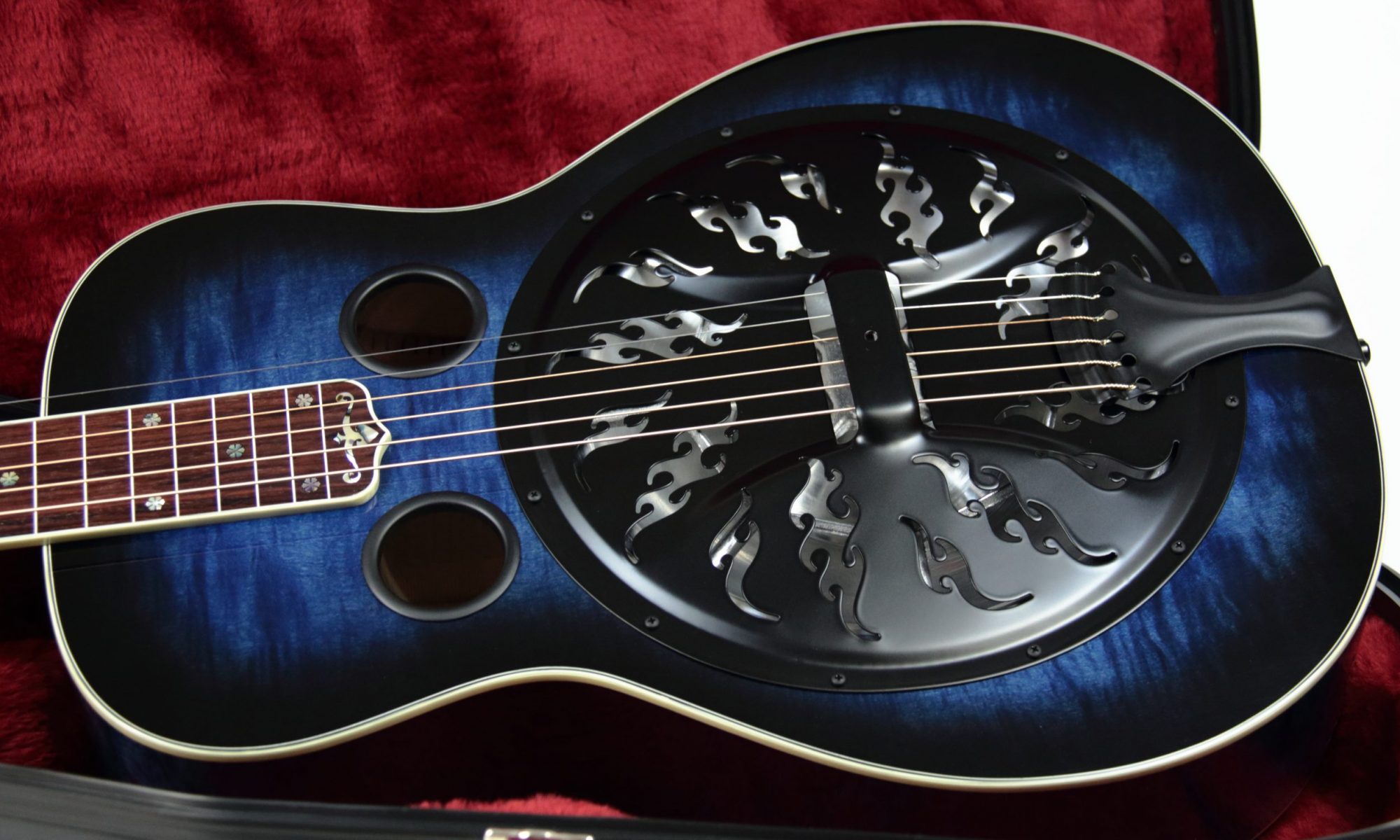How to orientate oneself in the number of possibilities that are accessible within ordering new instrument? In the case of resophonic guitar (a dobro) the offer range is quite wide.
Body/neck material – There are standardly three options. Type of material has essential impact on the sound color. Even though a lot depends on personal taste, I’ll try to describe the impact of material-types on the sound.
Maple body/neck – Maple represents some kind of starting point for a dobro. The sound proportion of bass/mids/highs is very well-balanced. When using medium density type of wood, the highs are nicely rounded but clear and strident at the same time. Ideal choice for a band where the maple sound of dobro shines next to the rest of instruments, because the sound color is unique and the sound characteristic narrow. But nothing is missing even when playing solo. Flamed maple vs classic maple – minimal sound difference. The wood’s figure here are lateral stripes caused by “ripple” effect. Flamed-figured wood is a bit less stable (a slight corrugation on the lacquer shows after awhile), but it has, on the other hand, a beautiful drawing and with the right final touch a magicall image might appear.
Rosewood and spruce body/ mahogany neck – Sound color is similar to guitar’s. The bass is proportionally very rich and powerful, mids are a bit less distinct and highs have slightly different character – they are much sharper. Depending on the spruce density of the front plate. It might be worse to push through in a band, because of the wide sound characteristic, but it depends on overall instrumental representation in the band. The sound is very rich and intense with solo playing.
Mahogany body/neck – Proportionally the bass is less distinct, but mids are strong and warm. The highs are rounded and less strident. The sound is less balanced, but has typically “mahogany” warm color. In a band the sound color is unique and rather narrow.
Furthermore various combinations are possible to achieve a different sound. In general, specific wood density plays an important role; whether it’s dense or sparse. So I would recommed specifying your idea of the sound color when ordering.
Fingerboard orientation
For proper orientation while playing, it is important to choose contrasting colors. In the case of ebony fingerboard and dark tortoise binding, the indistinctiveness of the fingerboard frame can be unpleasant. That is why with this combination I recommend adding inner facing of the fingerboard (black/white/black purflings), or choosing rosewood fingerboard + dark bindings.
Hardware (cone, spider)
In short: Sound differences between available components are small.
Resonator Cone ZC-1 has powerful, rather rounder sound.
BC-1/Beard Legend – powerful, slightly sharper sound.
Scheerhorn Cone – milder volume, but colorful sound.
There are many people experimenting with different cones and spiders. I guess some people just have to go through that, but I would like to share my own experience: After a long time of experimenting, I had come to following discovery – the most significant impact on the acoustic sound does not have the hardware (….nor software:-)…) but mostly the craft work on the intrument. In other words, it depends on how well the instrument is made, what is it’s construction – what type of wood or combination of woods is it made of. And then it comes to hardware such as cone and spider. This hardware has one main function: not to interfere with sound. Yes, it can affect the color and volume of the sound, but the wood and the craft work can affect it much more. If you own a good-quality instrument with good-quality hardware, you don’t need to experiment with different cone or spider. With cone it depends a lot if it’s malformed – by a screw that is too tight, or if it’s located too low, or if it’s old – tired of a string tension. That is why it needs to be occasionally replaced. How often depends on how well you treat the instrument. Of course playing technique has great impact on the final sound… But that would be a different topic.
Tuners
Schaller M6 vintage are standard tunning mechines for affordable price. They have minimal backlash and tendency to jump a bit downwards.
Schaller Grandtune are simply the best available tunning machines. They have a bit slower gear ratio, so the tunning takes longer, but is more precise. They have almost no backlash, they are very durable and resistent. There were no complaints so far… They don’t jump when tunning downwards, but tunes smoothly.
Pickups
These pickups are available:
Schertler Basik-Reso, Fishman Split Saddle Piezo(+AURA preamp), Amistar Piezo. You can listen to raw form of the pickup-sounds here: https://www.zacal.net/zvuky-snimacu/
Pickups don’t sound too similarly to the natural sound of dobro. It’s ideal to complete the pickup-signal with microphone, e. g. Sennheiser E608. Or use Fishman Aura, which adds a sample sound to the pickup-sound with chosen ratio – pre recorded sound of dobro. The first option seems to be more suitable, since the sound is more authentic.
